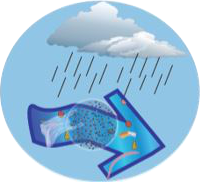|
|
WaterRain and runoff move waste pollution through the environment, over land and through waterways. Water transports, accumulates, disperses and deposits waste. Water can also disintegrate waste into smaller and more dispersible parts.  Quick facts
WaterRainfall runoff moves waste from streets, parks and other outdoor areas into the stormwater system, where it can flow into rivers, lakes, estuaries and oceans. The flow of waste pollution from the land via water movement is substantial, with approximately 80 percent of waste in the marine environment coming from land-based sources[6][2]. A worldwide study estimated that between 1.15 and 2.41 million tonnes of plastic waste per year currently enters the ocean from rivers[4]. A study in Townsville showed how the stormwater system contributes significantly to the movement of waste pollution through the environment[1]. One source of microplastics in the ocean originates from a protective coating on transport and container ships[5]. Many factors, such as biofouling, influence whether and how plastics are transported within and between different freshwater and ocean habitats[2]. Wastes with a density greater than seawater (≈1020 to 1029 kg/m3) will sink and accumulate in the sediment. Low-density particles tend to float on the sea surface or in the water column. Even low-density plastics can ultimately reach the seafloor. Research from China has found that riverine palaeochannels (a geological term describing a remnant of an inactive river or stream channel that has been filled or buried by younger sediment) and canyons carry plastic to the deep sea via turbidity currents. Waste pollution can alter natural runoff during heavy rain. For example, in February 2013, high concentrations of floating plastic between Shoalwater Bay and Townsville were found to be associated with large flooding events[3]. Improving water information outlines the Bureau of Meteorology’s understanding of rainfall across Australia, including averages, intensity and variability. The bureau and NASA (among others) have predicted more severe storms and cyclones, greater runoff and more flooding because of climate change. This will result in more movement of waste pollution through the environment. References
Last updated: 10 May 2021 This page should be cited as: Department of Environment, Science and Innovation, Queensland (2021) Water, WetlandInfo website, accessed 18 March 2024. Available at: https://wetlandinfo.des.qld.gov.au/wetlands/management/pressures/litter-illegal-dumping/pathways/water/ |

 — Department of Environment, Science and Innovation
— Department of Environment, Science and Innovation

